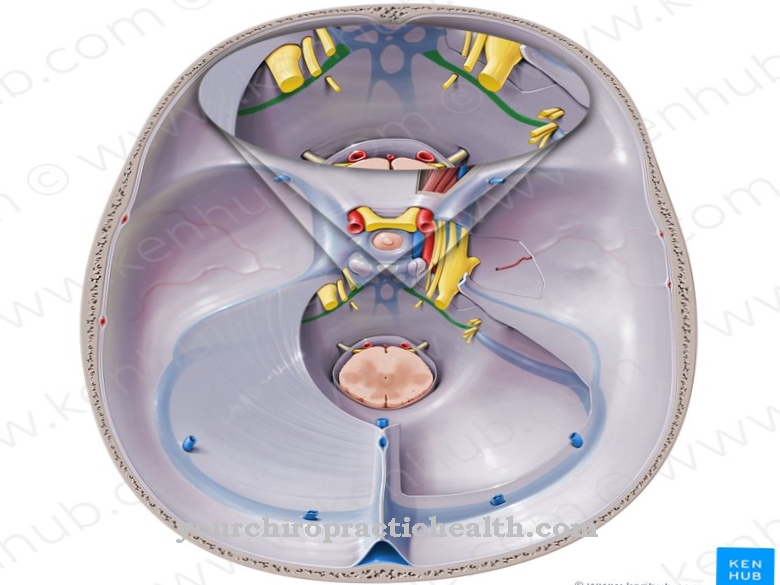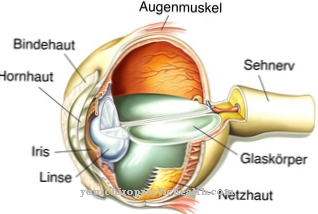The lymph is part of the lymphatic system, which is the most important transport system for the body besides the bloodstream.
It is responsible for detoxification, defense, cleansing of the body and complete health monitoring. It can affect many complications and clinical pictures. The main purpose of the lymph is to excrete pathogens, since together with the lymphocytes in the lymph nodes it destroys the pathogens.
What is the lymph?
The name lymph comes from the Latin word lympha, which means clear water. The plural form "lymphae" was used to designate Roman freshwater deities. Lymph is the name given to the light yellow, slightly milky, cloudy and watery liquid that is located in the lymph vessels and acts as an intermediate link between the tissue fluid and the blood plasma.
It collects in the tissue crevices and is also under the names Intercellular fluid and Tissue fluid known. It contains less protein compared to blood plasma. It is made up of electrolytes, proteins, chylomicrons and the white blood cells, which are also known as leukocytes.
Anatomy & structure
The lymph is created from extracapillary fluid that escapes into the intercellular space through the blood capillaries and can no longer return to the bloodstream. It washes around all cells. The cells take the substances they need from it and excrete their waste in the lymph fluid.
The lymph therefore contains waste materials that are to be removed from the intercellular space and therefore differs from the intercellular fluid. The lymph collects in the lymph capillaries, which combine to form larger vessels and lead to the lymph nodes. In the lymph nodes, the lymph is collected and filtered. The fluid leaves the lymph nodes through the discharge vessels.
The lymph vessels unite to form the lymphatic duct into which the lymph vessels that transport the absorbed fat from the intestine also open. The contents of the lymphatic duct pours into the clavicle vein on the left and in this way the lymph returns to the general bloodstream.
The human body produces two to three liters of lymph fluid per day. The lymph is made up of lymph plasma and cells. Its components are calcium, phosphate, potassium, creatinine, glucose, sodium, urea, catalase, diastase, lipase, dipeptidase, fibrinogen and fibrin precursors. Lymph from the stomach or intestines is usually cloudy in color and is called a chyle.
Function & tasks
The most important function of the lymph and the entire lymphatic system is to transport nutrients and waste materials. The lymphatic system, with its lymph vessels, which serve as pathways, plays the most important role in transporting the body in addition to the blood circulation. Disposal of pathogens, foreign bodies and bacteria takes place in the lymph nodes. The lymph removes dissolved substances, proteins and lipids and plays an important role in the immune system because it transports foreign bodies and germs to the lymph nodes, where the lymphocytes react to them.
The lymph and the lymph system are responsible for detoxification, tissue drainage and the immune system. All substances that cannot be removed directly from the tissue into the blood vessel walls of the bloodstream because it is not possible due to their molar mass or hydrophobicity are transported by means of the lymph. Excess fluid from the tissue is drained through the lymph vessels.
The lymph also takes on the transport of the lipids absorbed by the intestine, which first pass through the lymphatic duct, from where they reach the veins and the liver, where they are fed to the metabolism. The lymph assumes a very important function in the immune system, as it reacts to pathogens by forming lymphocytes and these can then be fought throughout the body. This multiplication of specific cells, the so-called T cells and B cells, in the lymph node is called the germinal center reaction.
Diseases
Since new tissue fluid is constantly forming, its removal through the lymphatic vessels can cause problems. In the case of illnesses it can happen that more fluid escapes from the capillaries than normal and thus the fluid cannot be removed as quickly.
One such disorder of the lymphatic system is the so-called lymphedema. This is swelling that occurs when the fluid in the tissue cannot drain away. This means that fluid accumulates in the tissue. The lymph builds up and the tissue swells. The extremities are increasingly affected by lymphedema, but edema can also occur in other parts of the body.
Pulmonary edema can be very dangerous, and it can lead to drowning in your own lymph that has accumulated in the alveoli. Pulmonary edema can develop when the left half of the heart is weakened and blood congestion forms in the small circulation.
Lymphangitis is a disease of the lymphatic system that is triggered by bacteria and causes inflammation of the lymphatic system. Lymphadenitis defines inflamed lymph nodes. Tumors can also spread through the lymphatic system. Cancer cells are transported by a primary tumor via the lymphatic vessels and form metastases.
The spread of tumor cells through the lymphatic system is also known as lymphogenic metastasis. In order to contain the metastasis, the lymph nodes are often surgically removed in cancer patients.
You can find your medication here
➔ Medicines to strengthen the defense and immune systemTypical & common diseases
- Hodgkin's disease
- Blood poisoning
- Lymphedema

























.jpg)


